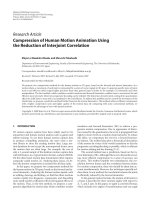Lecture M: Marketing (4/e) - Chapter 10: Marketing research
Bạn đang xem bản rút gọn của tài liệu. Xem và tải ngay bản đầy đủ của tài liệu tại đây (692.23 KB, 31 trang )
chapter
ten
marketing research
Copyright © 2015 McGrawHill Education. All rights reserved. No reproduction or distribution without the prior written consent of McGrawHill Education.
LEARNING OBJECTIVES
LO 10-1 Identify the five steps in the marketing
research process.
LO 10-2 Describe the various secondary data
sources.
LO 10-3 Describe the various primary data
collection techniques.
LO 10-4 Summarize the differences between
secondary data and primary data.
LO 10-5 Examine the circumstances in which
collecting information on consumers is
102
Step 1: Defining Objectives
and Research Needs
103
Step 2: Designing the Research
104
Step 3: Data Collection Process
Secondary data
Primary data
105
©Getty Images
Step 4: Analyzing Data
and Developing Insights
Converting data into information to explain, predict
and/or evaluate a particular situation.
106
Step 5: Action Plan and
Implementation
Digital Vision/Getty Images
107
check yourself
•
•
What are the steps in the marketing
research process?
What is the difference between data and
information?
108
External Secondary Data
Syndicated Data
Name
ACNielsen
(www.acnielsen.com)
Services Provided
With its Market Measurement Services, the company tracks the sales of consumer packaged
goods, gathered at the point of sale in retail stores of all types and sizes.
SymphonyIRI Group
(www.symphonyiri.com)
InfoScan store tracking provides detailed information about sales, share, distribution, pricing, and
promotion across a wide variety of retail channels and accounts.
J.D. Power and Associates
(www.jdpower.com)
Widely known for its automotive ratings, it produces quality and customer satisfaction research for
a variety of industries.
Mediamark Research Inc.
(www.mediamark.com)
Supplies multimedia audience research pertaining to media and marketing planning for
advertised brands.
National Purchase Diary Panel
(www.npd.com)
Based on detailed records consumers keep about their purchases (i.e., a diary), it provides
information about product movement and consumer behavior in a variety of industries.
NOP World (www.nopworld.com) The mKids US research study tracks mobile telephone ownership and usage, brand affinities, and
entertainment habits of American youth between 12 and 19 years of age.
Research and Markets
(www.researchandmarkets.com)
Promotes itself as a one-stop shop for market research and data from most leading publishers,
consultants, and analysts.
Roper Center for Public Opinion
Research
(www.ropercenter.uconn.edu)
Simmons Market Research
Bureau (www.smrb.com)
The General Social Survey is one of the nation’s longest running surveys of social, cultural, and
political indicators.
Yankelovich
(www.yankelovich.com)
The MONITOR tracks consumer attitudes, values, and lifestyles shaping the American
marketplace.
Reports on the products American consumers buy, the brands they prefer, and their lifestyles,
attitudes, and media preferences.
109
Courtesy The Nielsen Co
External Secondary Data
Scanner Research
IRI Website
1010
External Secondary Data
Panel Research
Group of consumers
Survey or sales receipts
©BananaStock/PunchStock
What are they
buying
or not buying?
Flying Colours Ltd/Getty Images
1011
Internal Secondary Data
1012
check yourself
•
What is the difference between internal
and external secondary research?
1013
Qualitative versus Quantitative
Data Collection Techniques
Qualitative research
Quantitative research
Data
collection
research
1014
Data Collection
In-Store Tracking Analytics
1015
check yourself
•
What are the types of qualitative research?
1016
Survey Research
1017
•
•
•
•
Response rates are
relatively high
Respondents may lie
less
It is inexpensive
Results are
processed and
received quickly
Simon Fell/Getty Images
Web Surveying
1018
Using Web Surveying
The McGraw-Hill Companies, Inc/
John Flournoy, photographer
How do firms successfully use web surveying?
1019
Experimental Research
AP Photo/Mary Altaffer
1020
Advantages and Disadvantages of
Secondary and Primary Data
Type
Secondary
Research
Examples
q
q
q
q
q
q
Census data
Sales invoices
Internet information
Books
Journal articles
Syndicated data
Advantages
q
q
Saves time in collecting data
because they are readily
available
Free or inexpensive (except for
syndicated data)
Disadvantages
q
q
q
q
q
Primary Research
q
q
q
q
Observed consumer behavior
Focus group interviews
Surveys
Experiments
q
q
q
q
q
Specific to the immediate
data needs and topic at hand
Offers behavioral insights
generally not available from
secondary research
q
q
q
q
q
May not be precisely relevant
to information needs
Information may not be timely
Sources may not be original,
and therefore usefulness is an
issue
Methodologies for collecting
data may not be appropriate
Data sources may be biased
Costly
Time consuming
Requires more sophisticated
training and experience to
design
study and collect data
1021
check yourself
•
•
What are the types of quantitative
research?
What are the advantages and
disadvantages of primary and secondary
research?
1022
The Ethics of
Using Customer Information
1023
check yourself
•
•
Under what circumstances is it ethical to
use consumer information in marketing
research?
What challenges do technological
advances pose for the ethics of marketing
research?
1024
Glossary
Data are raw numbers or other factual information
that, on their own, have limited value to
marketers.
Return
to slide
1025









